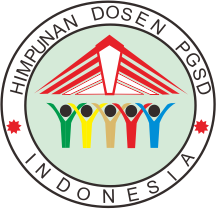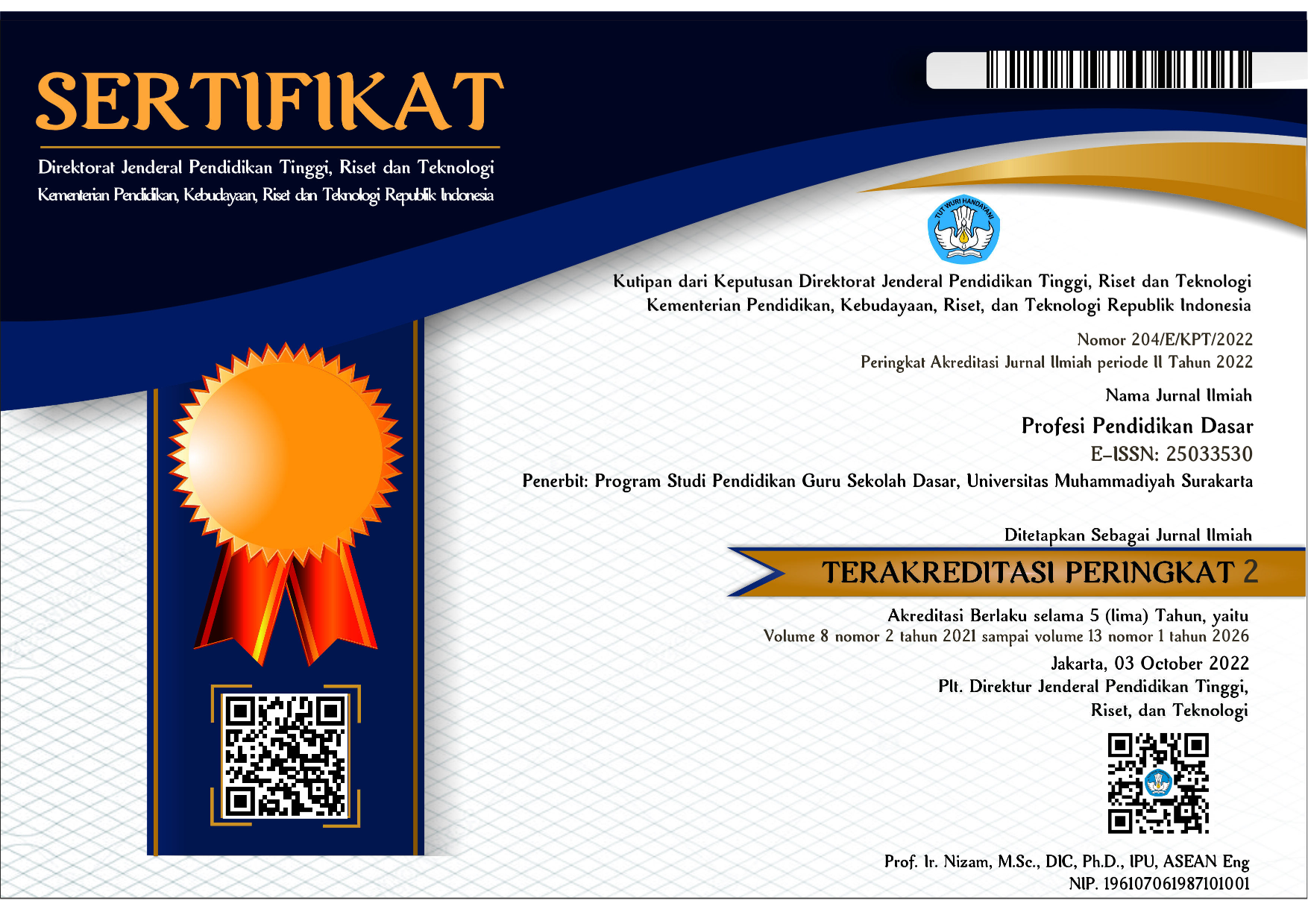SEKOLAH RAMAH ANAK BERBASIS HAK ANAK DI SEKOLAH DASAR
Luthfiana Ambarsari(1*), Harun Harun(2)(1)
(2)
(*) Corresponding Author
Abstract
Abstrak: This research aimed to describe the child-friendly school policy in two child-friendly pilot primary schools. This research concern: “How does the implementation of child-friendly school policy based child rights at primary school?” The method that used in this research was a qualitative type of phenomenology. The data were collected by observation method, interview, and documentation. The data analysis technique that used was phenomenology research data analysis of Burke Johnson and Larry Christensen. The results showed that there were 3 discoveries related to child-friendly school policies in primary schools. First, the child-friendly school policies were designed and implemented to ensure children's rights were fulfilled. Second, the child-friendly school policies were implemented in learning area, the school social environments, the school’s physical environment, and infrastructure facilities. Third, the child-friendly school policies were applied to create condition conducive and fun in school.
Keywords
Full Text:
PDFReferences
Adinarayana & Uma. 2015. Community Participation in Improving Enrollment, Retention and Quality of Elementary Education: A Case Study of Andhra Pradesh. Bulgarian Journal of Science and Education Policy (BJSEP), Vol. 9, No. 2.
Anderson J. et. al. (2016). Lively Social Space, Well-Being Activity, and Urban Design:
Findings from a low-cost community-led public space intervention. Journal Environment and Behavior, Vol. 49, No. 6. http://journals.sagepub.com/ doi/abs/10.1177/0013916516659108
Azimi L., et. al. (2012). Relationship between Maternal Parenting Style and Child’s Aggressive Behavior. Procedia - Social and Behavioral Sciences 69, hlm. 1276 – 1281
Bainham A., et. al,. (2003). Children and their Families: Contact, Rights and Welfare. Hart Publishing
Broberg A. et. al. (2013). Child-friendly urban structures: Bullerby revisited. Journal of Environmental Psychology 35, hlm. 110-120
Bruce M. (2014). The Voice of the Child in Child Protection: Whose Voice?. Soc. Sci. 3, hlm. 514–526
Carrasco C. et. al. (2017). Social Adjustment and Cooperative Work in Primary Education: Teacher and Parent Perceptions. Revista de Psicodidáctica
Corsi, M. (2002). The child friendly cities initiative in Italy. Environment&Urbanization Vol 14 No 2
Cross, D. et. al., (2012). The Friendly Schools Families Progamme: Three year bullying behaviour outcomes in primary school children. International Journal of Educational Research 53 hlm. 394-406
Davidson, D. (2011). Children’s Rights: The Right to Education. PDMU Team
Dewi, K.S. dkk., (2015). Children’s Aggressive Behavior Tendency in Central Java
Coastal Region: The Role of Parent-Child Interaction, Father’s Affection and Media Exposure. Procedia Environmental Sciences 23 hlm. 192 – 198
Elizabeth Heger, B. & Kim, M. (2009). International Human Rights Law, Global Economic Reforms, and Child Survival and Development Rights Outcomes. Law and Society Review Vol. 43 No. 3, hlm. 455
Epstein J.L. et. al. (2001). School, Family, and Community Partnerships: Preparing Educators and Improving Schools. Journal Resource Review
Frumkin H. et. al. (2006). Safe and Healthy School Environments. Oxford University Press
Gasser L. & Malti T. (2012). “Children’s And Their Friends’
Moral Reasoning: Relations With Aggressive Behavior”. International Journal of
Behavioral Development 36(5) 358–366
Gershoff E.T, et. al. (2017). Promising Intervention Strategies To Reduce Parents Use Of Physical Punishment. Child Abuse & Neglect 71, hlm. 9-23.
Habiby, Wahdan Najib dan Ika Candra Sayekti. 2016. “Pemenuhan Hak Anak Dalam Buku Siswa Kelas Lima Sekolah Dasar”. Jurnal Profesi Pendidikan Dasar Vol. 3, No.2, Desember, hlm. 71-83. http://journals.ums.ac.id/index.php/ppd/ article/view/4745.
Hay, I. et. al., (2016). Parent child connectedness for schooling and students performance and aspirations: An exploratory investigation. International Journal of Educational Research 77 hlm. 50-61
Howe R. B & Katherine C. (2011). Countering Disadvantage, Promoting Health: The Value of Children’s Human Rights Education. The Journal of Educational Thought 45, 1, hlm. 59
Jerome L., et. al. (2015). Teaching and learning about child rights: A study of implementation in 26 countries. UNICEF
Jiang, X. et. al., (2014). “Children’s Rights, School Psychology, and Well-Being Assessments”. Soc Indic Res 117, hlm. 179-193
Joussemet et.al., (2008). Controlling Parenting and Physical Aggression During Elementary School. Child Development Vol. 79, No. 2, hlm. 411 – 425
Khotib. (2012). Penerapan teknik supervisi observasi kelas dengan menggunakan CCTV di sekolah menengah pertama Al Falah Ketintang Surabaya. Skripsi. IAIN Sunan Ampel Surabaya
Lenzer, G. & Gran, B. (n. d). Rights and the Role of Family Engagement in Child Welfare: An International Treaties Perspective on Families’ Rights, Parents’ Rights, and Children’s Rights. Child Welfare Vol. 90, No. 4
Lester L. et. al. (2017). Family Involvement in a Whole-School Bullying Intervention:
Mothers’ and Fathers’ Communication and Influence with Children. J Child Fam Study
Loudova I. & Lasek J. (2015). Parenting style and its influence on the personal and moral
development of the child. Procedia - Social and Behavioral Sciences 174 , hlm. 1247 – 1254
Modipane M. & Themane M. (2014). “Teachers’ social capital as a resource for curriculum development: lessons learnt in the implementation of a Child-Friendly Schools programme”. South African Journal of Education, Vol. 34, No. 4
Peraturan Walikota. (2016). Peraturan Walikota Yogyakarta Nomor 49, Tahun 2016, tentang Sekolah Ramah Anak
Republik Indonesia. (2014). Peraturan Menteri Negara Pemberdayaan Perempuan dan Perlindungan Anak Republik Indonesia Nomor 8, Tahun 2014, tentang Kebijakan Sekolah Ramah Anak
Rytivaara A., (2012). Collaborative classroom management in a co-taught primary school classroom. International Journal of Educational Research 53 hlm. 182-191
Tichovolsky M. H. et. al (2013). Parent predictors of changes in child behavior problems. Journal of Applied Developmental Psychology 34, hlm. 336-345
Wuyts D. et. al. (2017). Effects of Social Pressure and Child Failure on Parents’ Use of Control: An Experimental Investigation. Contemporary Educational Psychology
Article Metrics
Abstract view(s): 2153 time(s)PDF: 2062 time(s)
Refbacks
- There are currently no refbacks.


















